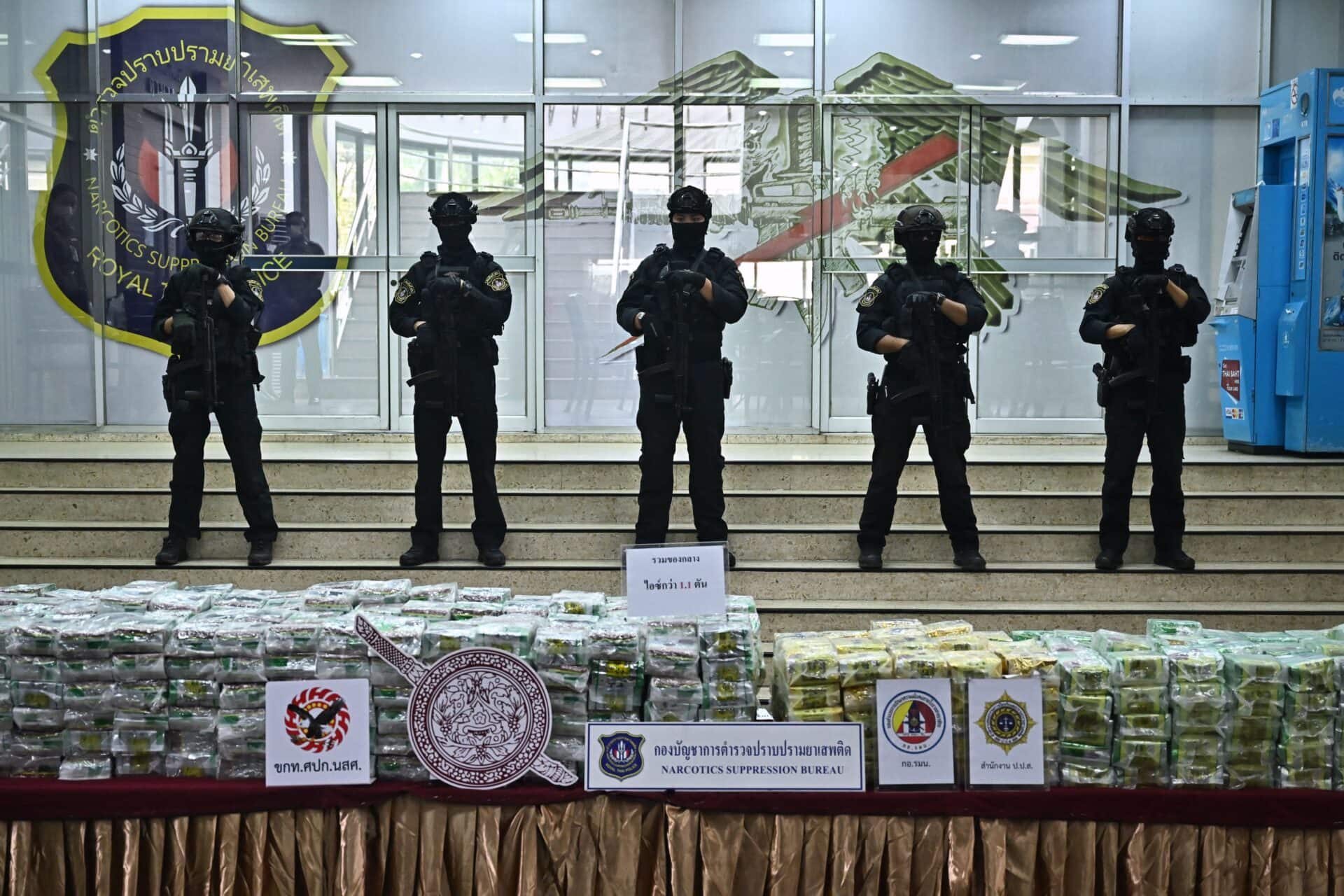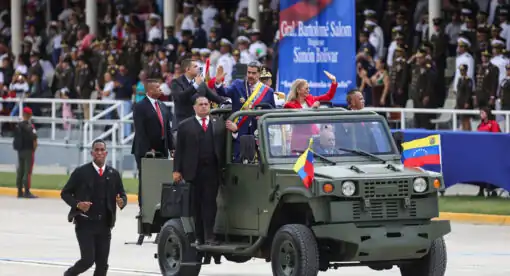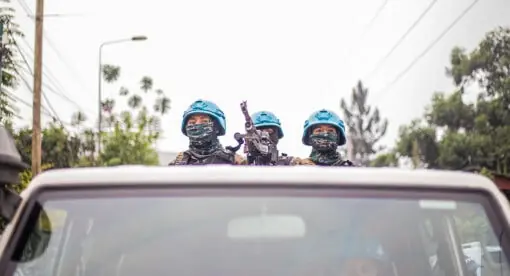Synthetic drug production has surged in regions where armed conflict and weak governance create ideal conditions for transnational criminal networks to operate. Myanmar’s ongoing civil conflict allows armed groups and criminal organizations to act with impunity, facilitating a significant expansion of synthetic drug production. Growing methamphetamine production in the Golden Triangle – the region spanning Myanmar, Thailand, and Laos – has attracted transnational criminal experts, chemists, and traffickers. Myanmar’s central location in Southeast Asia, with access to both overland and maritime trafficking routes, provides criminal networks with several pathways to reach lucrative markets across the Indo-Pacific region. Myanmar-based methamphetamine producers are expanding their trade through maritime trafficking routes, becoming increasingly adaptable and resilient while exploiting new infrastructure like China’s Belt and Road projects to reach new markets.
This escalating drug production poses significant challenges to U.S. strategic interests in the Indo-Pacific, as methamphetamine trafficking networks destabilize key American partners in the region, including Australia and the Philippines. This issue emerges as Southeast Asia becomes an increasingly critical theater for great-power competition between the U.S. and China. Unless effectively addressed, maritime trafficking routes could expand significantly, with the potential to increase transnational collaboration with Mexican criminal cartels in the wake of U.S. crackdowns on fentanyl and foreign terrorist organization designations. The U.S. should therefore develop a comprehensive approach to address this growing threat, focusing on enhanced regional cooperation and improved monitoring of methamphetamine trafficking networks originating in the Golden Triangle.
Supply Chain and Market Diversification
Amphetamine-type stimulants, particularly methamphetamine, represent a significant threat to regional security and public health. These synthetic drugs have dangerous effects on users, are relatively cheap to produce, can generate substantial profits for illicit actors as an alternative source of revenue, and can pose significant societal challenges including reduced productivity and greater demands on public health services. Methamphetamine producers in the Golden Triangle, concentrated in Myanmar’s Shan state, have demonstrated increasing resilience and adaptability in response to regulatory pressures, finding new and cheaper ways to synthesize these substances. This adaptability is demonstrated in their use of chemical precursors – the raw materials required for drug synthesis – which they have learned to diversify and conceal to maintain production capabilities despite law enforcement efforts.
The evolving patterns of chemical precursor use in the methamphetamine synthesis process reveal the complex adaptive strategies of Golden Triangle producers in response to regulatory pressures. Following intensified Chinese regulatory control over chemicals used in methamphetamine production in China, Golden Triangle producers, largely in Myanmar’s Shan State, diversified their synthesis methods in 2022 before returning to more traditional production processes by 2024. Chemical analysis of methamphetamine samples in 2022 from the Golden Triangle revealed a shift from traditional ephedrine and pseudoephedrine synthesis processes to ones using P-2-P methyl glycidic acid (P-2-P), with P-2-P synthesis accounting for 41% of samples tested that year. However, recent data from Thailand demonstrates a reversal: By 2024, ephedrine/pseudoephedrine-based synthesis methods increased to 79% of crystal meth samples, while P-2-P declined to just 5%. This trend suggests that rather than permanently abandoning traditional methamphetamine precursors, Golden Triangle producers have developed sophisticated strategies to maintain access to preferred precursors and synthesis methods.
While the finished product of P-2-P is regulated under the International Narcotics Control Board, and ephedrine/pseudoephedrine are controlled substances, methamphetamine producers in the Golden Triangle have adapted to those restrictions. Interchangeable, noncontrolled, and designer drugs – ones tailor-made with no legitimate use – can be used to synthesize P-2-P for the manufacturing of amphetamine-type stimulants. Further, producers use “analogue” chemicals similar to ephedrine/pseudoephedrine to avoid supply chain disruptions caused by regulatory frameworks. The virtual absence of seizures of ephedrine/pseudoephedrine and P-2-P, despite clear evidence of widespread use, demonstrate the precursor detection gaps in Southeast Asian supply chains. This points to producers becoming adept at diversifying precursors, illustrated in the short-lived increase of P-2-P usage in 2022, while also being better able to source and traffic preferred, traditional precursors, demonstrated in the return to ephedrine/pseudoephedrine after 2022. The evolution from diversification back to traditional methods, combined with sophisticated concealment strategies, presents challenges for counternarcotics efforts that must now address not only chemical substitution but also the invisibility of precursor supply chains.
Myanmar’s instability has reshaped methamphetamine market structures in the region, creating distinct production and trafficking patterns for crystal versus tablet forms that challenge traditional counternarcotics approaches. Data compiled by the U.N. Office on Drugs and Crime indicates that since the 2021 coup that replaced Myanmar’s democratically elected government with a military junta, the number of seizures for both crystal meth and methamphetamine tablets since 2021 have decreased, likely due to reduced interdiction capacity that is common in conflict-affected regions. The average quantities of methamphetamine seized per case since the coup has grown significantly, quadrupling for crystal meth and doubling for tablets. Paired with diverse branding discovered on seized tablets originating in Myanmar, the different rates of quantities of product seized per case since the coup could point to unique market structures for crystal versus tablet production.
Seizure data suggests that for methamphetamine tablets, production in Myanmar is decentralized and fragmented. Data from Thai seizures of tablets produced in Myanmar point to more varied branding since 2021. Further, while the quantity of tablets seized per case has increased since the coup, this increase has occurred at a much slower rate compared with that of crystal meth. This could point to Myanmar tablet production consisting of several smaller producers as opposed to a consolidated monopoly. Data on crystal meth seizures demonstrate a different market structure. The quantity of crystal meth seized per case is significantly higher relative to tablet seizures, signaling not only an increased production capacity since the coup, but potentially also market consolidation rather than competition. This could indicate that crystal meth production and trafficking are increasingly concentrated among fewer, more sophisticated groups that have rapidly scaled up operations since 2021.
The distinct market structures for crystal versus tablets has important implications for counternarcotics initiatives. For tablets, a competitive production environment renders traditional state authorities counternarcotics approaches that focus on targeting high-value individuals or specific organizations less effective, as eliminating one producer simply creates space for others to fill the gaps. While targeted enforcement against major producers might prove more effective for crystal than tablets, large-scale crystal producers are likely more sophisticated and adaptive, posing other challenges to law enforcement. Ultimately, these distinct market dynamics require product-specific counter-narcotics strategies that account for differing operational structures.
Methamphetamine prices in most of Southeast Asia have decreased over the last four years while purity has remained stable, signaling increased production capacity, making the drug easier to obtain by users. Data from the UNODC indicates that on average, retail and wholesale prices for both crystal meth and methamphetamine tablets have decreased in the region. In Myanmar, for example, one tablet cost around $2.50 in 2020, declining to approximately $1 in 2022, and to 60 cents in 2024. In the Philippines, the price of one gram of crystal meth has decreased by 30% since 2022. For wholesale prices, for which data is largely only available in Thailand, 2,000 tablets costing between $820-$1,147 in 2019 dropped to $240-$680 in 2023, and one kilogram of crystal meth which cost between $8,000-$13,000 in 2019 dropped to $2,700-$5,400 in 2023. Notably, the purity of methamphetamine tablets and crystal meth circulating Southeast Asian markets has remained stable, despite a decrease in price. Price drops and stable purity suggests that input costs for production have decreased while production capacity has increased.
Expansion and Growth
Myanmar’s border regions have transformed into diversified criminal enterprise zones where transnational organizations exploit governance vacuums to create mutually reinforcing illicit economies. The strategic convergence of drug trafficking infrastructure with cyber scam operations, illegal gambling, human trafficking, and environmental crimes demonstrate the ability of these groups to adapt and grow. Criminal groups in the Golden Triangle are using Special Economic Zones and casinos as physical and financial infrastructure to integrate their operations and launder profits across multiple illicit economies. This poses particularly complex challenges for regional security, as these interconnected enterprises create self-reinforcing cycles of corruption and instability in the country’s contested areas. Engaging in multiple illicit networks generates revenue that funds armed groups, undermines governance, and accelerates environmental degradation while providing trafficking organizations with diverse sources of income that make them more resilient to counternarcotics operations focused solely on drug interdiction.
Smugglers are using projects designed to enhance regional connectivity to expand methamphetamine trafficking routes in the Golden Triangle. China’s infrastructure projects in Myanmar’s Shan state, a key component of Beijing’s Belt and Road Initiative (BRI), have created enhanced conditions for methamphetamine trafficking. While the China-Myanmar Economic Corridor (CMEC) has largely stalled due to the ongoing war, smaller, completed projects like the Kunlong Bridge have created transportation infrastructure along key cross-border areas that criminal groups might exploit. Recognizing the opportunity associated with improved infrastructure, methamphetamine production labs have been popping up along CMEC routes, particularly around the town of Kutkai where militia-controlled territories intersect with newly developed transportation networks. This increased connectivity enables traffickers to easily source precursor chemicals from Chinese biomedical companies, pharmaceutical industries, and criminal syndicates, and conceal methamphetamine within the growing volume of legitimate cross-border trade. Future completion of CMEC projects, if not accompanied by increased monitoring of the contents of cross-border trade by law enforcement, will facilitate further expansion of methamphetamine trafficking, as once-remote areas will continue to become more accessible to criminal networks and afford them greater market access.
Myanmar’s methamphetamine trafficking networks have expanded from primarily land-based operations to sophisticated maritime trafficking systems, affording them market reach beyond Southeast Asia and creating serious challenges for counternarcotic enforcement in the Indo-Pacific. By integrating land corridors through the Mekong, trafficking networks are increasingly able to routinely move large methamphetamine shipments to major destination and transit markets in Australia, New Zealand, and South Korea, with the potential to expand farther to the Middle East and Europe. The emergence of large-scale maritime trafficking allows smugglers to circumvent traditional land-based interdiction efforts while significantly expanding the geographic reach of Myanmar-produced methamphetamine.
Beijing’s Approach
China’s approach to counternarcotics efforts regarding Myanmar’s drug trade reveals a complex dynamic of geopolitical interests and selective law enforcement. While China publicly promotes its tough anti-crime policies, its actual enforcement against drug trafficking is strategically calculated. Beijing’s law enforcement actions primarily target threats to the Chinese Communist Party’s power, activities that generate negative publicity in China, and criminal enterprises that directly harm Chinese citizens. China’s counternarcotics diplomacy, especially with the U.S. regarding fentanyl precursors, appears to be growing due to increased international pressure, but its operational cooperation often remains limited and self-serving. Chinese counternarcotics measures rarely move against the top echelons of Chinese criminal syndicates, especially those that advance Chinese political or economic interests in the region. These syndicates sometimes aid in informally spreading Chinese influence in strategic regions, whether through economic engagement or creating dependencies that can be leveraged for geopolitical objectives, all while affording Beijing plausible deniability for its role in exacerbating Myanmar’s instability.
This selective enforcement creates a permissive environment for Myanmar-based drug operations with Chinese connections. The opportunities associated with successful CMEC infrastructure for China are significant, despite aiding drug smuggling networks in the Golden Triangle. If Chinese criminal syndicates involved in methamphetamine smuggling from Myanmar work to protect CMEC projects from attacks, by either the junta or other actors, these syndicates advance Chinese Communist Party economic and political imperatives while maintaining smuggling routes that boost their profits. The result is a situation where Chinese criminal networks involved in Myanmar’s drug trade can often operate with relative impunity if they avoid crossing specific lines established by the party.
Threats to U.S. Interests
The narcotics-conflict cycle in the Golden Triangle threatens U.S. interests by prolonging the Myanmar civil war and enabling Chinese selective enforcement that advances Beijing’s economic and political imperatives. As Myanmar insurgent groups and junta-affiliated actors participate in the lucrative synthetic-drug trade, the resulting instability undermines American strategic objectives in Southeast Asia, while China’s counternarcotics approach creates a security environment that favors Chinese regional influence by affording Beijing better access to key areas in the region.
Myanmar’s conflict has created an environment where intensified fighting in some areas coincides with stability in key drug production zones, particularly in Shan state. This dynamic has enabled methamphetamine production operations to be concentrated in more stable regions to expand at a time when law enforcement capabilities are severely hindered. The underlying governance challenges in Myanmar, exacerbated by the ongoing conflict, create conditions conducive to large-scale synthetic drug production.
The illicit drug trade plays a role in financing insurgent activities in Myanmar, prolonging the civil war and destabilizing the region. Ethnic armed groups generate significant revenue through the production and trafficking of narcotics, particularly in Shan state, helping to fund and sustain the conflict. For example, the Arakan Army – a powerful insurgent ethnic armed organization primarily active in Myanmar’s Rakhine state – engages in drug trafficking networks in Shan state to generate revenue and weaken the junta. By forming ties with smaller ethnic armed organizations and narcotics networks in Shan state, the Arakan Army gains access to the drug trade and the profits that come with it, aiding the group in significantly weakening the junta’s position both in Shan and Rakhine states. While the junta accuses insurgent groups like the Arakan Army of using drug profits to fund their operations, the problem extends to some members of Myanmar’s military who are also allegedly involved in the trade, whether through consumption or as a revenue source. This narcotics-conflict relationship creates a self-reinforcing cycle that deepens existing ethnic grievances, strengthens drug trafficking networks in Shan state, and provides the financial resources necessary for continued conflict.
The infiltration of Myanmar-produced methamphetamine into U.S. partner countries undermines U.S. interests in the Indo-Pacific by destabilizing key security partners’ public health sectors, border security, rule of law, and governance. This destabilization comes at a time when regional cooperation is critical to counter China’s expanding influence. The negative impacts of methamphetamine produced in Shan state on Australia, the Philippines, and Indonesia work to destabilize these countries, two key U.S. partners and one geopolitically crucial nonaligned country, in a region of significant strategic importance in competition with China.
The Philippines has been hit particularly hard by Golden-Triangle methamphetamine trafficking. The country has seen significant surges in crystal methamphetamine use since Myanmar’s 2021 coup, and these numbers are on track to grow. Methamphetamine is trafficked into the country from the Golden Triangle primarily through maritime channels. In June, authorities stopped a fishing vessel attempting to smuggle 1.5 metric tons of methamphetamine, which was valued at around $175 million, into the Philippines. Both Former Philippine President Rodrigo Duterte’s war on drugs and current continued crackdowns focus overwhelmingly on arrests and extrajudicial killings rather than disrupting supply networks or implementing harm-reduction measures.
The increased availability of methamphetamines, demonstrated by reduced price in the country, overwhelms law enforcement, prison systems, border security, and health care systems. The strain methamphetamine trafficking has placed on Filipino law enforcement compromises the country’s ability to effectively control its borders and waterways, creating security vulnerabilities that China can exploit both through illicit networks and renewed BRI investments that facilitate dependency, a dynamic that the Philippines has made efforts to avoid. The Philippine government’s efforts to redirect funds from internal security to external defense are hampered by continuous penetration of illicit substances. With its resources committed to counternarcotics and drug interdiction rather than broader security cooperation, the Philippines’ capacity to serve as a reliable U.S. security partner diminishes, while competition with China intensifies.
Australia is on the verge of an epidemic: The country consumes the second-largest amount of methamphetamine per capita globally. Most comes from the Golden Triangle region. Raids in Thailand in 2023-2024 resulted in the discovery of over a metric ton of methamphetamine destined for Australia. These raids coincided with a significant increase in methamphetamine consumption in Australia in 2023, where the Australian Criminal Intelligence Commission observed a 1.5 metric ton increase in national consumption of methamphetamine through wastewater analysis. This epidemic strains health care and law enforcement resources, reduces economic productivity across particularly hard-hit regions, and has serious human costs. As maritime trafficking routes expand, production capacity scales up, and demand continues to grow, Australia will have to confront a growing health and human security crisis. This epidemic drains resources from defense and security priorities at a time when contestation in the South China Sea grows. The corruption of government institutions, particularly in border security and maritime enforcement agencies, creates governance gaps that reduce abilities to contribute effectively to regional security agreements. These vulnerabilities could provide China opportunities to expand influence by exploiting security vulnerabilities and governance weaknesses, ultimately undermining the U.S. security architecture in a region of growing strategic importance.
As a key nonaligned country in the Indo-Pacific, Indonesia’s growing methamphetamine trafficking problem poses a unique threat to U.S. strategic interests by potentially driving Jakarta toward greater dependence on China. Indonesia serves as both a major trafficking destination and transit route for Golden Triangle-produced methamphetamine. This year in May, authorities seized over two metric tons of methamphetamine in its largest bust to date. The product, reportedly originating from the Golden Triangle, was expected both to be distributed in Indonesia and transited further to markets in the Philippines and Malaysia.
The scale of the problem is draining Indonesian resources, with the head of its National Narcotics Agency saying drug trafficking has cost the country around $30 billion. This resource strain occurs as Beijing continues to pour money into Indonesia via the BRI, allowing China to position itself as a key partner in infrastructure and technology development. Indonesia is strategically important in great-power competition in the region, rendering strong Indonesian-American relations crucial for the U.S.’s Indo-Pacific policy. Given China’s strategic use of law enforcement cooperation as a diplomatic tool and its willingness to leverage counternarcotics assistance to achieve broader geopolitical objectives, Indonesia’s drug crisis creates an opening for Beijing to offer security assistance that could pull Jakarta further into China’s orbit. This dynamic threatens to undermine Indonesia’s traditional balancing between Beijing and Washington and reduce its potential to serve as a U.S. partner in limiting Chinese influence in some realms in the Indo-Pacific.
Forecasts
Southeast Asian Regional Security Will Face Growing Stress
Insurgencies funded by illicit drug proceeds and widespread corruption will increasingly challenge governance throughout Southeast Asia, requiring enhanced U.S. security cooperation with partners like Thailand, the Philippines, and Australia. As profits made from methamphetamine production and trafficking boost the strength of criminal and armed groups in Myanmar, border security challenges will intensify for neighboring countries. Corruption linked to trafficking will penetrate deeper into government institutions, further undermining political stability. This concerning security environment will strain the capacity of the Association of Southeast Asian Nations for regional coordination while creating conditions for increased Chinese influence through both legitimate and illicit networks, ultimately threatening U.S. strategic interests and partnerships.
Maritime Trafficking Routes Will Expand Significantly
Methamphetamine trafficking networks will increasingly utilize sea routes to circumvent traditional land border controls and take advantage of growing international demand, resulting in larger single shipments to countries beyond the immediate region. Myanmar’s strategic geographic position between China and India and its maritime routes to Australia, Japan, and potentially the Middle East and Europe create an ideal hub for global distribution as production capacity increases. If CMEC projects are realized in the near future, Shan state producers and traffickers will likely exploit new transportation infrastructure to expand reach even further. Regional navies and coast guards lack the capacity to monitor these waters effectively, and interdiction becomes harder with criminals’ use of technology like underwater drones in addition to increased sophistication with concealment methods. This creates opportunities for traffickers to establish reliable sea lanes that connect production zones to lucrative distant markets.
Collaboration With Mexican Cartels
While direct collaboration between Mexican cartels and Myanmar’s drug trafficking organizations is not extensively documented, there is evidence of indirect connections, and these links have the capacity to grow. For example, the Jalisco New Generation cartel in Mexico has documented contacts across China and India, with some evidence of links in Myanmar. Mexican cartels have sometimes engaged in knowledge sharing with chemists from China. The transnational reach of Mexican cartels continues to expand, with organizations like the Sinaloa cartel operating in at least 47 countries, often exchanging technical and scientific expertise about synthetic drug production and trafficking methods.
As both regions continue to adapt to law enforcement pressure and market demands, and as the Golden Triangle’s maritime trafficking capabilities improve, their capacity for collaboration could expand, especially as drug supply chains rapidly globalize. This offers criminal networks an “edge” as they seek to diversify and advance their methods, helping bypass interdiction risks. The far reach of Mexican cartels could lead to the establishment of infrastructure that could intersect with Myanmar’s growing drug production capacity, particularly as both regions increasingly focus on synthetic drugs like methamphetamine.
Policy Recommendations
Expand maritime interdiction capabilities in Southeast Asia through partnerships – The U.S. should establish a coordinated maritime interdiction partnership with partners and strategic countries in the region, such as the Philippines, Thailand, and Indonesia, to enhance monitoring and enforcement capabilities in key maritime trafficking corridors. This partnership should include technology transfer of advanced maritime surveillance systems, the provision of necessary and relevant interdiction-related equipment, and capacity-building and training through initiatives like joint exercises. This program should target maritime chokepoints used by traffickers moving drugs from Myanmar to international markets.
This partnership would work to limit traffickers’ transnational market access. Further, it would work to strengthen regional security partnerships and promote stability in Southeast Asian waters, potentially limiting opportunities for China to exploit vulnerabilities in this strategically vital arena.
Implement a comprehensive monitoring mechanism of the drug trade in Southeast Asia – The U.S. intelligence community must establish a multilayered monitoring system of the drug trade in Southeast Asia, particularly focused on the Golden Triangle region. This enhanced surveillance framework should be established through an interagency intelligence program, combining resources from the State Department’s Bureau of International Narcotics and Law Enforcement Affairs, the Drug Enforcement Agency, the CIA, the military’s Indo-Pacific Command, and other agencies to improve monitoring. This mechanism should use satellite imagery, human intelligence, signals intelligence, and collaboration with regional partners to produce up-to-date mapping of evolving trafficking networks. The system should track cultivation pattern changes in Shan state and maritime and land trafficking routes that connect Southeast Asia with potential new markets beyond the region.
This expanded monitoring would better enable the U.S. to detect early signs of collaboration between Southeast Asian traffickers and Mexican and South/Central American cartels. This recommendation is in line with President Donald Trump’s administration’s emphasis on drug cartel crackdowns. While Mexico has been the priority, this administration should also seek to preemptively limit the opportunities for other cartels, like those in the Golden Triangle, to grow.
Enhance current precursor chemical tracking system – The U.S. must implement an enhanced tracking system to monitor shipments that might signal chemical diversification of drug inputs. This mechanism should be modeled after the U.N.’s Global Rapid Interdiction of Dangerous Substances Program and include the development of a comprehensive system that tracks both controlled chemical precursors and non-scheduled “pre-precursors.” This can be done through the creation of a database that tracks industrial chemical shipments between Southeast Asia, China, the Indo-Pacific, and key transit countries as well as through the expansion of “watch list” chemicals that are not formally controlled but have illicit applications.
This program should be particularly focused on precursors used for methamphetamine production and should include an emphasis on the monitoring of shipments between China and Myanmar, Thailand, and Laos. This enhanced chemical monitoring system will strengthen efforts to identify, and therefore disrupt, Southeast Asian cartel supply chains. This will also work to reduce transnational collaboration between Mexican and Southeast Asian cartels, thereby limiting their ability to share expertise.
The views expressed in this article are those of the author and not an official policy or position of New Lines Institute.






